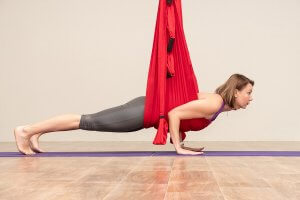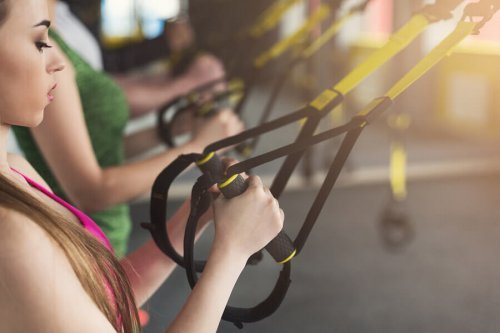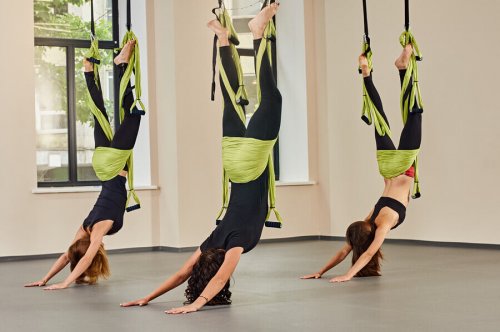Suspension Pilates: A Step Beyond Pilates

In the following article, we’ll discuss a new way of working out: suspension Pilates. Before we go deeper into the subject, it’s important to know and master traditional Pilates so that it’s easier to carry out the suspended version.
The Pilates Method, which we’ve discussed in previous articles, is a very intense and demanding discipline, provided that we master it correctly. It’s important to highlight again that the two crucial pillars on which this method is based, and which are key for suspension Pilates:
- Body control
- Core work
Differences between suspension Pilates and traditional Pilates
This type of training allows us to perform multidimensional, useful, effective, and safe exercises using one’s own body weight and the force of gravity. The latter helps with developing strength and, at the same time, improves flexibility, balance, and stability in the core.
That’s, broadly speaking, a definition of what we know suspension training to be. Is there anything more functional than Pilates that you can do while suspended in the air?
We can say that the combination of both—Pilates and suspension training—is the perfect combination since both are complementary disciplines. These are two methods that can merge in a completely natural way, with the following objectives:
- Correcting exercises that affect the core and overall abdominal region.
- Improve posture.
- Activation of the stabilizing muscles necessary for executing more challenging moves.

All this is possible based on our body weight’s support work, but also through the execution of other exercises, especially balance-related ones. These, with the help of hand grips such as the TRX, gives us a different and innovative view of the Pilates Method.
On the other hand, there’s also a lot of work involving destabilizing tools that are usually used in normal Pilates classes: the stability ball, foam rollers, stability cushions, and BOSU balls.
By using these materials, we can dramatically improve our proprioception and develop greater precision of movement. All this affects our neuromuscular systems and becomes a real challenge for the body.
What does suspension Pilates implicate?
Many questions can come up at first when thinking about suspension Pilates. Will it be easier or harder than traditional Pilates? Is it very different from traditional Pilates?
When we use TRX to perform the workout, suspension Pilates represents both great difficulty and a bigger effort for the abdominal muscles. Stabilization exercises are key for this reason.
The stabilizing component
As we said, it’s one of the most important parts of this method of workout. In a few words, the less support we have, the more difficult the exercise will be. On the contrary, if we have more than one support, the difficulty will decrease.
That’s why suspension Pilates becomes interesting since it involves different support mechanisms that will enable us to advance in this discipline. In many cases, the TRX straps can serve as footholds, facilitating the exercises we are going to practice.
Breathing and concentration
Another point to address is breathing control as well as maintaining concentration. These are essential when performing Pilates exercises in suspension.

Conclusion
To summarize it all, suspension Pilates is a method of combined training that offers a greater variety of exercises. It also increases the playful component, which makes classes more fun.
Additionally, it’s a modality that unites the Pilates working technique with an innovative instrument, such as suspension ropes—TRX. In this way, it’s possible for instructors to develop greater creativity, which in turn benefits students.
If you’ve already tried Pilates, don’t wait any longer to experiment with this innovative form of exercise. Suspension Pilates is waiting for you. Ready to get started?
In the following article, we’ll discuss a new way of working out: suspension Pilates. Before we go deeper into the subject, it’s important to know and master traditional Pilates so that it’s easier to carry out the suspended version.
The Pilates Method, which we’ve discussed in previous articles, is a very intense and demanding discipline, provided that we master it correctly. It’s important to highlight again that the two crucial pillars on which this method is based, and which are key for suspension Pilates:
- Body control
- Core work
Differences between suspension Pilates and traditional Pilates
This type of training allows us to perform multidimensional, useful, effective, and safe exercises using one’s own body weight and the force of gravity. The latter helps with developing strength and, at the same time, improves flexibility, balance, and stability in the core.
That’s, broadly speaking, a definition of what we know suspension training to be. Is there anything more functional than Pilates that you can do while suspended in the air?
We can say that the combination of both—Pilates and suspension training—is the perfect combination since both are complementary disciplines. These are two methods that can merge in a completely natural way, with the following objectives:
- Correcting exercises that affect the core and overall abdominal region.
- Improve posture.
- Activation of the stabilizing muscles necessary for executing more challenging moves.

All this is possible based on our body weight’s support work, but also through the execution of other exercises, especially balance-related ones. These, with the help of hand grips such as the TRX, gives us a different and innovative view of the Pilates Method.
On the other hand, there’s also a lot of work involving destabilizing tools that are usually used in normal Pilates classes: the stability ball, foam rollers, stability cushions, and BOSU balls.
By using these materials, we can dramatically improve our proprioception and develop greater precision of movement. All this affects our neuromuscular systems and becomes a real challenge for the body.
What does suspension Pilates implicate?
Many questions can come up at first when thinking about suspension Pilates. Will it be easier or harder than traditional Pilates? Is it very different from traditional Pilates?
When we use TRX to perform the workout, suspension Pilates represents both great difficulty and a bigger effort for the abdominal muscles. Stabilization exercises are key for this reason.
The stabilizing component
As we said, it’s one of the most important parts of this method of workout. In a few words, the less support we have, the more difficult the exercise will be. On the contrary, if we have more than one support, the difficulty will decrease.
That’s why suspension Pilates becomes interesting since it involves different support mechanisms that will enable us to advance in this discipline. In many cases, the TRX straps can serve as footholds, facilitating the exercises we are going to practice.
Breathing and concentration
Another point to address is breathing control as well as maintaining concentration. These are essential when performing Pilates exercises in suspension.

Conclusion
To summarize it all, suspension Pilates is a method of combined training that offers a greater variety of exercises. It also increases the playful component, which makes classes more fun.
Additionally, it’s a modality that unites the Pilates working technique with an innovative instrument, such as suspension ropes—TRX. In this way, it’s possible for instructors to develop greater creativity, which in turn benefits students.
If you’ve already tried Pilates, don’t wait any longer to experiment with this innovative form of exercise. Suspension Pilates is waiting for you. Ready to get started?
All cited sources were thoroughly reviewed by our team to ensure their quality, reliability, currency, and validity. The bibliography of this article was considered reliable and of academic or scientific accuracy.
- Boix-Vilella, S., León-Zarceño,E., Serrano, M.A. (2014). ¿Hay beneficios psicosociales por la práctica de pilates? Un análisis de la literatura científica. Cuadernos de Psicología del Deporte, vol. 14, 3, 117-128
- Zarzoso-Muñoz, M., Encarnación-Martinez, A. (2008). Base científica en la práctica de Pilates. Congreso: III Simposio Internacional de la CC de la Actividad Física y el Deporte. Valencia 2426 de Abril de 2008. ISBN: 9788461235179
This text is provided for informational purposes only and does not replace consultation with a professional. If in doubt, consult your specialist.








